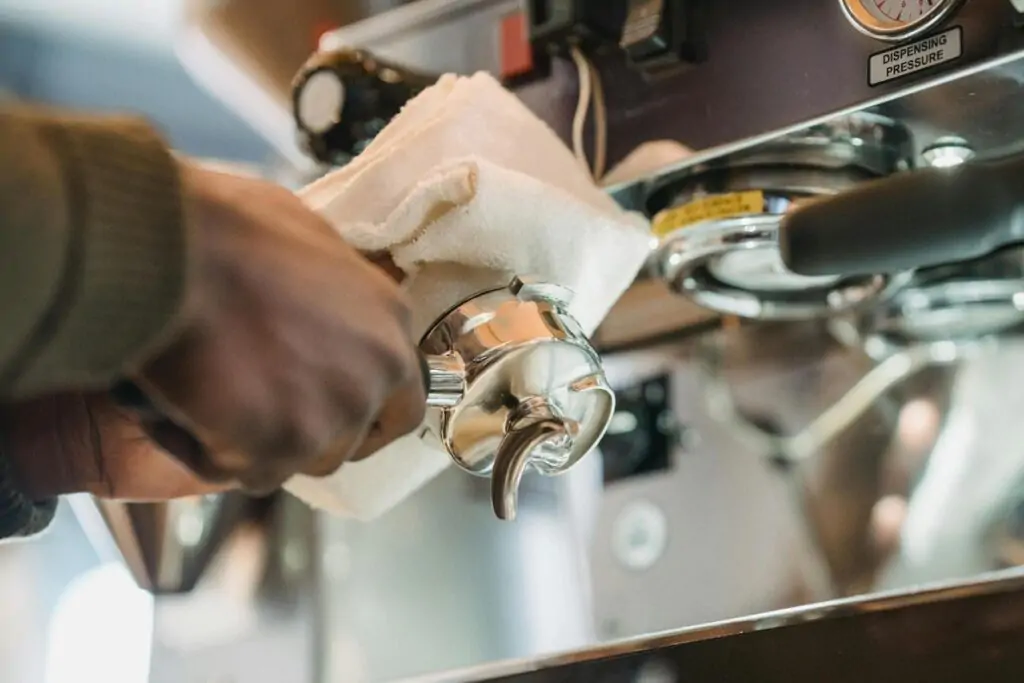How to Clean Espresso Machine with Vinegar: A Complete Guide

I once ignored my espresso machine’s limescale buildup and ended up with a sputtery mess—until vinegar saved the day. Your espresso machine is the superhero of the morning routine, grinding out shot after shot of liquid gold. But like any superhero, it requires a little care (or love) to continue serving at its peak. Over time, mineral deposits, coffee oils and milk residue can accumulate, gumming up the works and muting that perfect espresso flavor. The good news? You don’t have to lay out so much cash for fancy descalers or pay for a maintenance pro to come fix it. A cheap bottle of vinegar is all it takes to restore your machine. In this guide, we’ll show you step-by-step how to clean espresso machine with vinegar, so you can keep your coffee tasting fresh and your machine running smoothly.
Vinegar is a natural, affordable, and effective way to tackle the gunk that accumulates in your espresso machine. But before you start pouring, there are a few things you need to know to do it right. Stick with me, and I’ll share everything from safety tips to pro hacks, so you can clean like a barista without the fuss.
Why Cleaning Your Espresso Machine Is a Must
Every time you brew a shot, water leaves behind tiny mineral deposits, especially if you’ve got hard water. Coffee oils and milk splatters add to the mess, coating the internal parts and dulling your machine’s performance. Left unchecked, this buildup can:
- Slow down water flow, making your shots take forever.
- Mess with the temperature, leading to under-extracted or burnt-tasting coffee.
- Clog the steam wand, turning your silky lattes into foamy disasters.
Vinegar’s acetic acid breaks down calcium carbonate in limescale—here’s why that matters for your brew quality. But cleaning isn’t just about the inside—keeping the group head, portafilter, and steam wand spotless ensures every part of your machine works in harmony. Let’s get into how to do it safely and effectively.
Is Vinegar Safe for Your Espresso Machine?

You might be wondering, “Is vinegar safe for espresso machines?” It’s a fair question, and one lots of folks ask. The answer is: usually, but it depends on your machine. Studies from coffee experts, like those at the Specialty Coffee Association, confirm vinegar’s safety for most machines—just avoid overusing it. Vinegar is great for stainless steel or brass components, but it can be trouble for aluminum parts or rubber seals. Here’s why:
- Aluminum: Vinegar can corrode it over time, so if your machine has aluminum internals, skip the vinegar and opt for citric acid or a commercial descaler.
- Rubber Seals: Prolonged exposure to vinegar can wear them down, especially in areas like the steam wand.
As a barista with 5 years of experience, I’ve cleaned countless machines. So, how do you know? Check your machine’s manual or do a quick search for its specs. If you’re unsure, play it safe with a gentler cleaner. But for most home espresso machines, vinegar’s a solid choice—just use it wisely.
Preparing the Vinegar Solution
Before you start, you’ll need to mix the right vinegar solution. Too strong, and you risk damaging your machine; too weak, and it won’t cut through the grime. Here’s the sweet spot:
- Ratio: Mix 1 part white vinegar to 1 part water (1:1). This balance is strong enough to dissolve scale but gentle on most machines.
- Amount: Fill your machine’s water tank with the solution. For a small tank, a cup of each should do; for larger tanks, scale up.
- Type of Vinegar: Stick with white vinegar. It’s clear, odorless, and won’t leave behind any funky flavors. Apple cider or balsamic? Save those for your salad.
Got a super-sensitive machine? You can dilute it further—say, 1 part vinegar to 3 parts water—but you might need an extra cycle to get the job done.
Step-by-Step: How to Clean Espresso Machine with Vinegar
Now, let’s get to the good part—cleaning your machine. The process varies slightly depending on whether you’ve got a semi-automatic, automatic, or super-automatic machine, so I’ve broken it down for you.
For Semi-Automatic and Automatic Machines
1. Fill the Tank: Pour your 1:1 vinegar solution into the water tank.
2. Run the Solution Through: Turn on the machine and run it as if you’re pulling a shot. Let the solution flow through the group head into a cup until the tank is empty.
3. Let It Soak: If your machine’s got stubborn scale, let the solution sit for 15-30 minutes to break it down.
4. Rinse Thoroughly: Refill the tank with fresh water and run it through the machine twice to flush out any lingering vinegar.
5. Wipe Down the Parts: Use a cloth dipped in a diluted vinegar mix (1 part vinegar to 4 parts water) to clean the group head and portafilter. Avoid soaking rubber parts.
For Super-Automatic Machines
These high-tech wonders often have a built-in descaling cycle. Check your manual for specifics, but here’s the gist:
1. Use the Descaling Mode: If your machine has one, pop in the vinegar solution and follow the on-screen prompts.
2. Manual Option: No descaling mode? Follow the semi-automatic steps, but be extra cautious with internal components.
Cleaning the Steam Wand (With Caution)
Another common question: “Can I clean the steam wand with vinegar?” Not directly. Vinegar can damage the wand’s seals, so here’s a safer way:
- Wipe It Down: After each use, wipe the wand with a damp cloth to remove milk residue.
- Purge It: Run steam through to clear out any milk stuck inside.
- Soak the Tip: If the tip’s removable and clogged, soak it in hot water—not vinegar.
The first time I rinsed my machine post-vinegar, I was amazed at how much gunk came out—proof it works!
If your old espresso machine is driving you crazy despite all your efforts, it’s time for a change. Check out our top picks for hassle-free machines here!
Common Mistakes (And How to Avoid Them)

Even with the best intentions, cleaning mishaps happen. Here’s how to sidestep the most common pitfalls:
- Using Too Much Vinegar: A stronger mix doesn’t mean a better clean—it can leave a taste or damage parts. Stick to 1:1.
- Not Rinsing Enough: If your coffee tastes like salad dressing, you didn’t rinse properly. Run fresh water through at least twice.
- Ignoring the Manual: Every machine’s a little different. Skipping this step could void your warranty or lead to costly repairs.
If you spot white flakes after cleaning, that’s likely undissolved scale. Run another descaling cycle or flush more thoroughly to clear it out.
How Often Should You Clean with Vinegar?
Here’s another one people often ask: “How often should I clean my espresso machine with vinegar?” It depends on how much you use it and your water hardness:
- Regular Use (a few shots weekly): Descale every 1-2 months.
- Hard Water Areas: Monthly descaling might be necessary.
- Light Use: Every 3-4 months should do.
For daily maintenance, wipe down the group head and purge the steam wand after each use. It’s quick and keeps things running smoothly between deep cleans.
Maintenance Tips to Keep Your Machine in Top Shape
Cleaning with vinegar is just one piece of the puzzle. Here are some extra tips to keep your espresso machine humming:
- Use Filtered Water: Cuts down on mineral buildup and reduces descaling frequency.
- Empty the Drip Tray: A full tray can breed mold—dump it daily.
- Brush the Group Head: A small brush (or even an old toothbrush) works wonders for coffee grounds.
Stick to these habits, and you’ll spend less time scrubbing and more time sipping.
When Vinegar Isn’t the Best Choice
Vinegar’s great, but it’s not a one-size-fits-all solution. Here’s when to consider alternatives:
- Aluminum Components: Opt for citric acid or a commercial descaler to avoid corrosion.
- High-End or Super-Automatic Machines: Some require specific cleaners—check your manual.
- Heavy Buildup: For serious scale, a commercial descaler might pack a stronger punch.
Here’s a quick comparison to help you decide:
| Method | Pros | Cons | Best For |
| Vinegar (1:1) | Cheap, natural, effective for light scale | Can corrode aluminum, possibly taste issues | Casual users, stainless steel machines |
| Citric Acid | Odorless, eco-friendly, strong | Slightly pricier, may need multiple cycles | Eco-conscious users, tough scale |
| Commercial Descaler | Machine-specific, reliable | More expensive, chemical-based | Frequent users, sensitive machines |
Troubleshooting: Fixing Post-Cleaning Woes
Sometimes, things don’t go as planned. Here’s how to handle common post-cleaning issues:
- Vinegar Taste in Coffee: You didn’t rinse enough. Run fresh water through two or three more times, then brew a throwaway shot to check.
- White Particles in the Water: Leftover scale—run another descaling cycle or flush thoroughly.
- Machine Not Heating Properly: Vinegar might’ve loosened scale that’s now clogging the system. Try flushing again or consult a pro.
If your machine still tastes off after cleaning, try a second rinse—hard water can leave stubborn deposits.
My First Vinegar Cleaning Disaster (And What I Learned)
Let me save you from my rookie mistake. The first time I cleaned my machine with vinegar, I used way too much—straight vinegar, no water. Big oops. My next espresso tasted like a salad gone wrong, and it took five rinse cycles to fix it. Now, I stick to 1:1 and rinse like my life depends on it. Lesson learned: follow the ratios, and don’t skimp on the rinse.
Final Thoughts: Keep Your Machine Happy, Keep Your Coffee Perfect
Cleaning your espresso machine with vinegar is a simple, cost-effective way to maintain its performance and extend its life. By following these steps, you’ll not only keep your machine in top shape but also ensure every shot you pull is as bold and flavorful as it should be.
Disclaimer: Vinegar works wonders, but always check your machine’s manual—some brands void warranties if you skip their recommended descalers. Your machine—and your taste buds—will thank you.
Got a cleaning tip or a funny mishap to share? Drop it in the comments—I’d love to hear your story. Now, go give your machine some love and enjoy that next perfect espresso!
